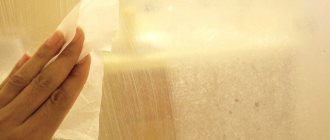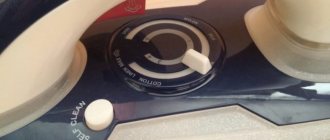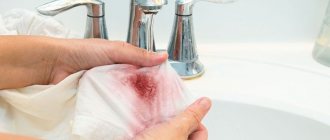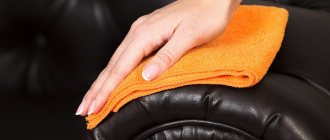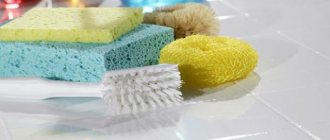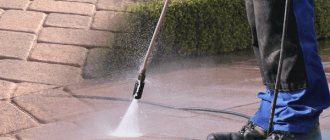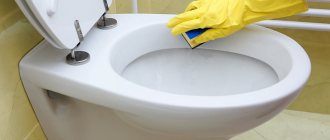Fighting specific stains
Contaminants on a ceramic sink can be of different nature: rust, plaque, dyes, grease. It’s not easy to deal with such stains, but you can choose special-purpose formulations from among the range of detergents. Therefore, the type and nature of contamination must be determined.
White limescale
It is nothing more than water salts that remain on the surface of the sink after the moisture has dried. You can avoid their appearance by installing a filter. Improving the quality of water means freeing it from salts, and less plaque is formed. If this is not done, white spots and stains will appear. They are not easy to remove, but it is possible.
How to remove plaque from a ceramic sink? You can use home methods:
- treating the washing surface with a bleach solution once a week. You need to close the drain hole, apply liquid, leave for 20 minutes, rinse with warm water and wipe dry;
- scrubbing away plaque stains using household bleach. Please note that this composition is quite aggressive. It is not recommended to use it more than once every 14 days. Before use, you will need to dilute it with water (1:3) and treat the sink with a spray bottle and leave overnight (up to 14 hours). Then wipe with a sponge and rinse with water;
- Vinegar is one of the first aides when cleaning a ceramic sink at home. It is simply applied to the surface, allowed to stand for 3 minutes and rinsed. For old stains, apply a cloth soaked in vinegar and leave for 15–20 minutes;
- ammonia. Another handy tool that will help remove limescale stains. How to clean a ceramic sink from plaque using ammonia? It's simple: you need to make a special composition from water and this product, adding a few drops per 200 ml of liquid. Apply the product to the sink, leave for 10 minutes and rinse off.
Although the list contains available means, when working with them, as with industrial compounds, you should adhere to safety rules. Before cleaning the sink, you need to wear gloves and a respirator. Caustic substances can cause ulcers on the hands, and toxic fumes can lead to poisoning or burns to the respiratory tract.
Removing traces of rust
Worn out taps and old fittings often lead to red spots appearing on sinks. This is rust. It distorts the beauty of a ceramic sink. If you leave stains, then over time they eat away, and it becomes very difficult to clean them. Therefore, it is worth removing contaminants literally immediately after they form. Home remedies will help with this.
How to clean a ceramic sink if it has rust? Remember effective recipes:
- A solution of ammonia peroxide in proportion 1: The resulting product is applied with a sponge to the rust stain and left for a while. When the components are mixed, a chemical reaction occurs that helps clean the composite. Then you just need to rinse the sink with water. It is advisable to clean it with ammonia peroxide once a week so that rust does not have time to eat into the material.
- Coca-Cola + spray bottle. You may be surprised, but the world-famous drink perfectly cleanses the composite of contaminants. You need to spray Cola on the stains and leave for an hour. Next you will need to rub the stain with a sponge and rinse with water. The same method works with cleaning other delicate surfaces - acrylic, enamel. Several processing cycles - there will be no trace of rust left.
In addition to a sponge, you should stock up on an old brush (toothbrush, for example). It is convenient to wipe off dirt from corrugated surfaces.
After cleaning the sink from rust, you should treat the surface with a vinegar solution. It will act as a disinfectant.
Removing traces of coffee
Stains from this drink, like tea, appear as yellowness. You can fight them with lemon juice. You just need to lubricate the contaminated areas with half the fruit, then rub and leave for a couple of hours.
When there is no citrus in the house, but there are stains from coffee and tea, you can use a concentrated solution of citric acid or store-bought products. For example, Pemolux will help. It is sold in powder, which must be diluted with plain water before use. Next, the paste should be applied to the surface of the sink and wait a little.
Fighting varnish stains
These are the most difficult contaminants. They cannot be removed with conventional detergents, which only smear the stain. You can remove nail polish or paint from a ceramic sink using White Spirit solvent.
You need to moisten a cloth or cotton swab in a chemical solution and wipe the stained areas. However, it is important to consider that the solvent is a very toxic and caustic substance. It can damage the surface of a ceramic sink, so it should be used carefully and in small quantities.
Causes of limescale deposits
The appearance of an unpleasant whitish layer is typical not only for surfaces in the bathroom. This coating forms on many surfaces that are constantly in contact with water. This is a sink, bathtub, faucets, tiles, toilet, heating element of a washing machine and even a kettle. What are the reasons for its formation?
Plaque is formed due to the evaporation of tap water remaining on the surface of the sink or faucet.
Reference. Limescale is predominantly solid deposits of calcium and magnesium salts that enter the water supply system in dissolved form from groundwater and limestone artesian wells.
A layer of deposits on plumbing spoils not only its appearance. Precipitated calcium and magnesium salts:
- narrow the passage of pipes (especially in places of bends);
- reduce heat transfer from heating elements of household appliances, leading to rapid wear and reduced service life;
- disrupt the operation of moving elements of taps and valves;
- lead to the destruction of enamel under a layer of deposits;
- reduce the elasticity of rubber gaskets and seals.
From the above it follows that the fight against limescale is not only a matter of aesthetics, but also concern for the serviceability and durability of plumbing equipment and household appliances.
Types of sinks and their care
Before cleaning the sink from stains and yellow deposits, you will have to prepare for a hygiene procedure. To do this you will need:
- Remove small debris from the drain. If necessary, clean the drain hole with a plunger. If you don't have a plunger, you can clean the drain with a salt solution. To prepare it, you need to combine two parts warm water and one part table salt.
- Remove unnecessary items from plumbing fixtures - dishwashing gel, liquid soap, sponges, toothbrushes.
- When using cleaning products that contain chlorine, alkalis and acids, ventilate the area and wear protective gloves.
- Prepare soft sponges and sponges that do not scratch surfaces.
Also, when choosing a cleaning agent, you should consider what material the plumbing fixtures are made of. Below we will discuss in detail how to clean different types of sinks.
Enameled
It is quite difficult to care for enamel sinks, since all stains, water deposits and rusty stains are very clearly visible on the shiny surface. In order for such plumbing fixtures to always shine, it is necessary to wash them with gel-like and creamy detergent compositions:
- CIF Active Lemon;
- Sanita;
- Sarma;
- Sidelit.
To clean rust from an enamel tulip sink, use freshly squeezed lemon juice. Procedure:
- Using a soft cloth, apply lemon juice to the stained areas;
- wait twenty to thirty minutes for the product to take effect;
- clean off the rust with the hard side of the sponge;
- wash off dirt with cool water.
To remove yellow stains from a white enamel sink, you must use purified gasoline or nine percent table vinegar. Exposure time is fifteen to twenty minutes.
Stainless steel
A stainless steel kitchen sink is the easiest to clean. Because stainless steel is not susceptible to the settling of lime and grease, as well as the appearance of dark spots. To ensure that such a product always looks neat, you can do the following once a week:
- close the drain;
- fill the sink with hot water;
- add any dishwashing gel that you can find in the house;
- Without releasing the water, walk over all surfaces of the sink with a sponge;
- drain the soapy liquid and rinse the plumbing.
In a situation where dark stains do appear on stainless steel, the following life hack will help to clean a stainless steel sink:
- Place a saucepan with peeled potatoes on the fire.
- Wait until the potatoes are completely cooked.
- Close the drain hole of the metal sink and pour potato broth into it.
- Wait fifteen to twenty minutes.
- Then use a sponge to clean the most problematic areas.
Cast iron sink
Iron and cast iron washbasins can be cleaned either with aggressive products containing caustic compounds or with hard sponges. However, fresh stains are best washed off with regular dishwashing detergent.
If your cast iron sink is stained with grease, remove it with baking soda. To do this, you need to liberally apply an abrasive agent to the wet surfaces of the sink, and actively rub them with the hard side of the sponge. Then - rinse the cleaned plumbing fixtures generously with warm water.
Chrome or nickel plated parts of taps, mixers, aerators, sprayers
No coarse or abrasive products, no metal brushes - all this can irreversibly damage the decorative coating and it will not be possible to restore it later.
To remove limescale from the holes in the shower head , it should be disassembled. Soak parts with nozzles in heated 9% vinegar for 30–60 minutes. Then rinse with water and, if necessary, brush with a toothbrush. Assemble the watering can and attach it back to the hose. If you can’t disassemble it, then soak the entire tip of the watering can.
The same thing applies to the aerator (the nozzle on the faucet spout). It should be removed - it unscrews easily.
Then rinse in running water, soak in heated 9% vinegar for 30–60 minutes, rinse again in water, if necessary, clean off the softened plaque with a toothbrush and screw it back on.
When soaking plumbing parts in vinegar, do not forget to cover the container with cellophane to minimize evaporation.
We clean the chrome or nickel plated parts of the faucet from water stone.
- Lemon. If the contamination is not too serious, you can get by with regular lemon: rub the parts of the mixer with a slice of lemon. Leave for 20-30 minutes, then rinse with a sponge soaked in water and wipe dry.
- Vinegar. More serious lime deposits can be removed with vinegar. Moisten the parts with 9% table vinegar. Wrap the most contaminated areas with pieces of cloth or napkins soaked in vinegar. Wait about half an hour, rinse, clean hard-to-reach areas with a toothbrush, and wipe dry.
For final cleaning of nickel and chrome plated surfaces, removing dark spots or stains, toothpaste is excellent. Apply a small amount to the cotton wool and rub thoroughly until shiny. Remove any remaining paste with cotton wool or a dry cloth and enjoy the cleanliness!
Unpleasant smell
A clean sink is only half the battle. Its shine will not please you if it emits unpleasant “odors.” Particles of food remain in the pipe, they begin to decompose - hence the smell. It is very persistent, but you can get rid of it in two proven ways:
- Vinegar + soda. 100 g of soda is poured into the drain and the same amount of table vinegar is poured. After this, a hiss will be heard and foam will begin to emerge from the pipe - this indicates the beginning of cleansing. After ten minutes, boiling water is poured into the drain, which should remove the accumulated dirt.
- Mole. This tool has been in demand for many decades, because it copes with the task. You just need to pour the required amount of the composition into the drain and fill it with water according to the instructions.
What are the types of bath stains?
The surface of the bathtub can change its color for various reasons. The most common of them:
- Soap residue. It is formed when using gels, foam, shampoo and other hygiene products. During the washing process, they are removed from the body along with dirt and dead skin particles. As a result, a thick, dirty coating forms on the bathtub, which darkens over time.
- Yellowness. This problem is associated with the formation of rust. Its particles penetrate into the water supply through old pipes. Gradually, the drips become more pronounced, penetrating into the structure of the construction material.
- Lime deposits. Calcium salts often settle on taps, tiles and bathtubs. When in contact with soap, they form whitish stains on the surface of plumbing fixtures. In addition, limescale deposits are often caused by hard tap water.
Special cleaning products
When choosing products for cleaning a sink, it is recommended to give preference to products marked “for composites”. Chemicals should not be aggressive. Choose a product without acetone, solvents and strong inorganic acids.
"Buggy Shumanit"
The form of the substance is cream, suitable for cleaning granite and artificial stone. Has a slight polishing effect. The composition of the product clogs pores, restoring the shine of the product.
Prosept Cooky Spray
Presented in spray form. Easy application eliminates stains, grease and various types of deposits.
Cilit Bang
Thanks to the spray form, it is convenient to apply to the surface. The cleaning formula removes even the most stubborn stains. Apply to problem areas and after rubbing with a sponge, wash off with water.
Mellerud
The product not only cleans porcelain tiles, but also cares for them at the same time. Suitable for daily cleaning of ceramic sinks. When working with a cleaning agent, it creates a protective film on the surface.
"Mister Muscle"
The effect of the spray is cleaning, disinfection and polishing. The formula of the drug penetrates into hard-to-reach places, cleaning the slightest contaminants. Eliminates dried and old stains. Special products for cleaning artificial stone sinks are easy to use. Kitchen chemicals effectively remove stains. After their work, not a single trace remains on the surface.
Cleaning a very dirty sink
If the sink that is now in front of you is in such a terrible state that you don’t know where to start - don’t despair! We will tell you how to wash it and it is not an easy task. However, we warn you that you will need to operate it in several stages. First of all, stock up on everything you need:
- dishwashing liquid (optional, dishwashing powder);
- vinegar;
- soda ash;
- special means for cleaning sinks;
- tools - sponges, rags, brush.
Powder for the dishwasher is also perfect.
There will be four stages of work. Shall we begin? Stage 1:
- Plug the drain and fill the sink with hot water. This will somehow dissolve the fat and remove limescale.
- Add dishwashing liquid or powder and let the product work on the grease for some time.
- Drain the water.
- Scrub the walls and bottom of the sink with a brush or stiff sponge.
Stage 2:
- Treat those stains that you were unable to wipe off using a sponge and your own hands with soap, soda or a special cleaner for sinks.
- Leave them to act for 10-20 minutes.
- Brush again and rinse with water.
Inexpensive and effective remedy
Stage 3 (if the drain is clogged or there is an unpleasant odor coming from it):
- Pour half a cup of soda ash down the drain. Then pour the same volume of vinegar there.
- After the reaction has passed, pour boiling water into the drain.
An easier alternative would be to use special means - “Mole”, “Tiret”, “Mr. Muscle”.
Stage 4 (disinfection and shine): As a final touch, rub the inside of the sink with a cloth soaked in vinegar, and then wipe the sink dry. You will see more visual tips in the video in this article.
Another good tool
Folk remedies
The best care for your sink is prevention. After each use, the sink is treated with any available product and wiped dry. Thus, the sink will last a long time.
Lemon
The acid contained in the fruit can dissolve any dirt. Eliminates rust and yellow plaque. Removes even traces of dried food.
Mustard powder
Use exclusively on newly planted spots. Disinfects the surface. The surface is cleaned with powder or a soft paste is made from it.
Ammonia hydrogen peroxide solution
Mix the components in equal proportions, apply a sponge to the stain, rub it, leave for 2 minutes, rinse with clean water. Repeat once a week until rust is removed.
Baking soda
Not for use in dry form. Before cleaning, prepare the paste. Removes coffee, tea and rust stains.
Coca Cola
Place a spray bottle on the bottle, spray the rusty areas with the drink, and leave for 1 hour. Wash off with water and wipe easily with a sponge. The procedure is carried out once a week for a month, after which the red spots disappear.
Chalk
A mixture of whitish powder fights advanced spots. Chalk is diluted with hydrogen peroxide. The resulting slurry is applied to the contaminated areas. The application areas are additionally covered with a film to create a greenhouse effect. You can also use tape. The dry powder is removed and the surfaces are treated with water.
Gel toothpaste
A good, inexpensive option for cleaning porcelain tiles. Suitable for light kitchen sinks. Not only cleans surfaces, but whitens them.
Prevention of yellow plaque
Getting rid of yellow plaque can be very difficult. That is why it is easiest to prevent its occurrence than to waste time and effort in the future.
It is important to remember simple tips:
- After each use, rinse the bathtub with clean water and wipe dry with a cloth.
- When using plumbing cleaning products, always follow the instructions for use. There is no need to exceed the dosage or keep the solution longer than prescribed.
- Always thoroughly remove any remaining detergents or cleaning products.
- Keep taps, mixers, and plumbing fixtures in working order. Remember that constantly dripping water is the main cause of yellow streaks.
- Select specialized products to care for your plumbing fixtures.
Never use iron sponges or harsh abrasives to clean your bathtub. Don't forget to take care of your plumbing every day. Remember that competent and high-quality care of your bathroom will preserve its appearance for many years.
A little about security
Before starting work on cleaning the sink, regardless of its type, be sure to wear gloves. All detergents contain substances that irritate the skin to a greater or lesser extent. When working with vinegar, you need to be especially careful, especially when using it in concentrated form. It would be useful to use a respirator and safety glasses.
It is always easier to carry out preventive work than to deal with the consequences. Therefore, you should not run the car wash until it is in an emergency condition. It is enough to do a little preventive cleaning once a week using the most gentle products; the sink will delight the eye with its cleanliness for a long time.
Removing other types of contaminants
In addition to the above, there are also rarer types of pollution. But fighting them also does not require much effort.
Potassium permanganate and brilliant green
Any, even a very weakly concentrated solution of potassium permanganate leaves brown spots on the surface of the bath. You can destroy them with hydrogen peroxide, lemon juice or citric acid. A bonus after cleaning with these products will be not only whiteness, but also shine.
Diamond green is removed with alcohol, but this method is not suitable for acrylic bathtubs - the stain will remain.
After renovation
When carrying out renovations in an apartment or house, it is worth closing the bathtub in advance to protect it from getting construction debris and materials on its surface.
If the bathtub does get dirty, then don’t worry, you can wash it:
- If paint gets on the surface, any solvent, for example White Spirit, will help get rid of it. But don’t delay the cleaning process, otherwise the paint will dry out and it will be more difficult to remove.
- Construction dust can be washed off with soap and water. To add whiteness and shine, the bath is treated with lemon juice or acid.
Sealant
The joints and seams are sealed with sealant; if it gets on the surface of the bathtub, it will be quite difficult to wipe off. There are several ways:
- Mechanical removal with a stationery knife. It is worth remembering safety precautions and wearing gloves and safety glasses.
- Chemical - use products that dissolve the sealant. A solvent such as White Spirit is suitable for these purposes.
Preventive measures
It is necessary to prevent the formation of stains on stainless steel if possible. To do this, resort to the following prevention:
Do not leave leftover food inside the sink. After washing the dishes, you need to remove all pieces of food.
- Abrasives. They provoke scratches and are superior to available means, so you should not use them on a regular basis.
- Dirty dishes. You should wash it right away; you should make it a rule not to leave it in the sink overnight.
- Polishing. Once every two weeks, it is recommended to polish the sink with olive or vegetable oil - this will keep it shiny.
- Metal brushes. They may cause scratches on the surface.
Even severe stains on stainless steel should not cause horror. There are many ways to clean it. And useful tips will help you keep your kitchen clean, the main thing is to stick to them.
Boric acid - cleaning and disinfection
A safe product with a disinfectant effect can be found in any pharmacy. Sold in powder or solution form. Boric acid can be used to clean teapots and sinks. For better results, you can mix it with lemon juice. To remove traces of limescale from the toilet, pour the powder into it overnight and rinse it off in the morning.
Useful tips
To ensure that the cleansing procedure does not take much time, you must:
- Carefully select a cleaning agent for the material of the unit;
- Clean the walls of the device daily to avoid the accumulation of dirt;
- Use protective gloves when working with aggressive concentrates;
- To make the surface shine, you need to rub the product with olive oil or wax;
- Do not leave dirty dishes in the bowl for a long time.
Our tips will help you clean your kitchen sink from stubborn dirt.
We hope that these methods will be useful for caring for sinks and will answer the question of how to clean a sink at home.
Question answer
Can different plaque removers be mixed to increase effectiveness?
No, the products must be used in accordance with the instructions for use. Moreover, when mixing some acids and alkalis, substances may be released that are harmful to human health.
Which rust removers are more effective: acidic or alkaline?
Acid-based products work best to combat traces of rust. However, when choosing them, consider the type of bathtub. Some surfaces, such as acrylic, can be damaged as a result of improper use of acidic agents.
What products can be used to prevent yellow plaque?
The formation of yellow plaque can only be prevented by daily maintenance of plumbing fixtures. It is also necessary to keep the taps in good condition.
Is it possible to get rid of yellow plaque only using folk methods?
If the coating is fresh, it is not rust, then you can get rid of such contaminants using traditional methods. However, only professional chemistry will save you from rust and old contaminants.
Is it possible to clean an acrylic bathtub with a steel brush?
Iron brushes are contraindicated for acrylic surfaces, like any other rough cleaning agents.
How to whiten a steel bathtub
Steel bowls, like cast iron, are coated with a thin layer of enamel . When damaged, low-carbon iron alloys corrode faster than high-carbon ones, so steel baths are prone to spot yellowing in areas of scratches, punctures and chips of the coating.
Folk remedies
Effective cleaning methods include:
- Wash with a mixture of salt and turpentine. Mix 40-50 ml of turpentine and 5-6 tbsp. finely ground salt. Apply to darkened enamel, rub and leave for 10-20 minutes. Rub again and rinse off the mixture.
- Soaking in Coca-Cola. This drink contains phosphoric acid, which is used to remove oxides. To get rid of limescale, rust and stains, you need to cover the dirty areas with gauze soaked in Coca-Cola, leave for 1-2 hours and rub with a sponge. Wash the clean surface and wipe with a dry cloth.
For steel bowls, you can also use products recommended for cast iron baths.
Purchased funds
For a steel bath, any cleaner designed for enamel surfaces is suitable. If the product is recommended for earthenware and ceramics, then it can only be used for washing toilets, sinks and tiles.
To avoid scratches, you need to choose mild forms of chemicals: foams, creams, gels, sprays and liquids.
Bleaching an old bathtub from rust and dirt
Yellowed bathtub enamel and old stains can be removed with the following substances:
- WD-40 is a drug that is used as a water repellent for vehicle repairs. At home, it can be used to dissolve rust and clean stains, as it contains a solvent.
- You can clean the bathtub with soda and peroxide for fresh stains; for old stains it is better to use applications from this composition. Apply peroxide and soda to a rag, then apply it to the stain. After a few hours, the mixture should be washed off with water.
- Whitening bathtubs with soda ash has proven to be effective. The baking soda must first be dissolved in vinegar or water to avoid scratching the coating. The mixture is applied to dirty areas and washed off after 5-10 minutes.
- You can purchase special anti-rust products for enamel surfaces.
